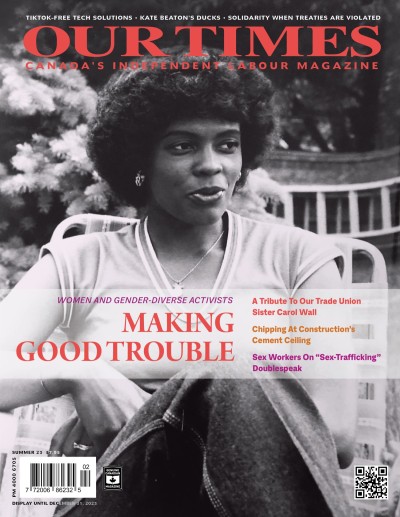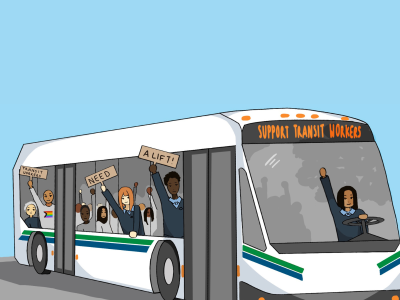I should admit up front that, in 30 or more years of having a chequing account, I have never had a properly balanced chequebook. Numbers, columns, rows and totals all drive me crazy.
What I like most about Bill Murnighan's piece is that it's forward-looking and balanced. We have the benefit of having watched what's happened to the movement in places like the U.S. We have the luxury of being able to learn from others' mistakes and victories, and to move more deliberately. I'm especially impressed by Bill's resistance to the enthusiasm that's so common today for the "everything into organizing" approach. New members are good, but first contracts are even better. And good first contracts mean satisfied new members, who become great organizing contacts.
Bill's piece has got an "organizing is not just about certification" tinge to it. I'm an organizer. I guess you could say I certify people for a living (no jokes please! I've heard them). But too many of us see organizing as a process that's political — one that radicalizes workers — to the point where labour boards say, "You can stop all that stuff and get structural: elect a committee or two and start sitting down with the employer." Bill isn't saying that. He doesn't start out that way in his article, and he doesn't finish that way.
But, while Bill sees recruiting new members as part of a seamless process of organizing workers in the broadest sense, he's using analytical tools and methodologies that I'm not sure still hold. He's talking numbers — quantifiable indicators of success or failure in recruiting new members.
I think there's a relationship between the way most of us think about organizing as a process separate from the other things we do in our unions, and the obsession we all have with measurements of union density (the percentage of workers who are unionized in a given area of employment).
I can see the need to conceptualize what organizers and activists do, and how unions should be changing those things: we need and want a way to figure out if what we're doing is working. But there's a problem inherent in this approach that we need to think about. It's an approach that follows a structure to labour relations that the labour movement didn't ask for or determine on its own. In fact, if I remember my labour history correctly, we were headed in another direction entirely: towards industry-wide unions, not workplace-specific bargaining units. Then along came the state and the employers.
We got stuck with a legal structure to labour relations that evolved in the U.S. It wasn't imported because it was American; it migrated north because it had been proven to be useful and workable — for employers and the State, not for workers. The State, through labour legislation, tells us what we can bargain for (or not), when we can bargain, and when we can and cannot strike. The process is beyond structured: it's straitjacketed.
Anyone who's talked to a trade unionist from a country other than the U.S. knows that the North American system of workplace or enterprise-based bargaining units is far from the norm. And if you look at places like Britain, which has recently begun to migrate towards the North American model, you'll see that the effects favour employers, not workers.
It's not for nothing that staff who do what in Canada and the U.S. would be considered largely servicing work, such as bargaining with the employer and handling grievances, are called "organizers" in Australia, among other places. There, and in most other advanced capitalist countries, a union (or even more than one union) can often represent workers in a workplace, or across an entire industry, without having demonstrated majority support. Members work alongside non-members, and the number of members — those who make the effort to pay dues each month and who see the advantage of supporting the union — may even be a small minority in a workplace. So, in places like this, the strength of the union is determined not just by the percentage of workers in an industry ("union density"), but, more importantly, by the extent to which the demands of the union have the support of the non-members in the workplace.
It's a very different system of labour relations and one that doesn't always lend itself to the numbers game. Instead, the proof is in the pudding. Or the strike. Bill points out that French unions have about nine per cent membership. That is, about nine per cent of French workers pay dues to a trade union. But French unions can mobilize industry-wide strikes in the public and private sector in which the vast majority of workers participate.
Think about that for second.
In Canada, we count bargaining units. Before we get to a bargaining unit we count heads. Then we count cards. Then we count votes.
I'm a little leery of the numbers game we all tend to fall into when looking at our successes and failures in "organizing." Compare our numbers with the French numbers. We have a bigger percentage. They succeed in having a million or more workers (not all members) strike over changes to the equivalent to CPP/QPP. Clearly there's something more at work than percentages.
I'm not saying we're more or less militant; only that I think we need to move outside the box of thinking in terms of bargaining units and votes and certifications. More than anything, we need to remember that the box wasn't of our making. So throwing it away isn't a betrayal of anyone or anything we hold dear.
A small example of how the box and the numbers mix: We measure our success in terms of the percentage of eligible workers who choose to join a union. But we don't define who's eligible. The government(s), largely at the behest of employers, do. Presumably, the day the Ontario government took the right to organize away from agricultural workers, the percentage of organized workers in Ontario actually went up.
Huh?
I get even more confused by the numbers and what they mean when I look at what our sisters and brothers are doing in countries like India, Argentina, Zimbabwe, and in the unofficial unions of China. Some of the most vibrant unions I know of don't have a single member in the Canadian sense of the term. They have no formal structure, and collect dues on a pay-what-you-can basis. All they may have are contracts (sometimes not even that, just an unwritten understanding between the workers and the employers), and a wildly active — well, not membership exactly, but — well, a bunch of workers who get together to do things for themselves.
In the South, workers often strike over social rather than simply econ-omic issues, including issues like the privatization of water, or reductions in old age pensions. And they strike against systems. These un-ions, and their members, are less likely to be minor partners in political parties and more likely to dominate those parties (and the policies they put forward), or to act as a political party themselves.
In some ways our labour movement is starting to look and (to a lesser extent) work outside the box. Many of us have already recognized that political parties aren't the be-all and end-all for political action. Our (initially) younger members and, more importantly, those in sectors where they're not likely to become members in the short term, are turning away from established parties, including the NDP, and playing a new game. They talk about "affinity groups," not riding associations. They don't play electoral numbers games. They act outside the boxes the State and political traditions created for us. They've forged a whole new set of tools and are probably responsible for the fact that just about anyone with a TV or a radio has a working definition of the word "globalization."
I can't say I have any answers, nor even many of the questions. But the best starting point for any re-thinking of what we do and how we do it is to throw out all our assumptions and see if we can't generate an ongoing debate.
Let's start with tossing the numbers. If nothing else, it's a lot more fun to fight over ideas and concepts than percentages and totals. And, in the end, it'll take us a lot further, too.
Bill touches on one of those concepts, but skirts it a bit as well.
Centralizing bargaining, negotiating neutrality agreements, and many of the other ideas Bill presents all work, but only when the workers in those fragmented workplaces have some structural solidarity in the form of one union. Does it really make sense to keep reconstituting councils of unions (bringing several unions together to bargain, as one, with an employer) when what the workers really need is one union? Does union density of more than 50 per cent in an industry mean anything if that density is spread among five or 10 or 20 unions? With that many unions representing one employer's workers, can any one union negotiate a neutrality agreement? How effective is a council of unions when each union has a significantly different organizational culture and resource base?
Does union density mean much if we don't or can't do anything with it?
Derek Blackadder is the co-ordinator for LabourStart in Canada and an honourary member of the Toronto Workers' History Project’s Archive Committee. Feedback and ideas for future WebWork topics welcome.
If you like what you're reading and want to subscribe to Our Times, please go here. Thank you!










